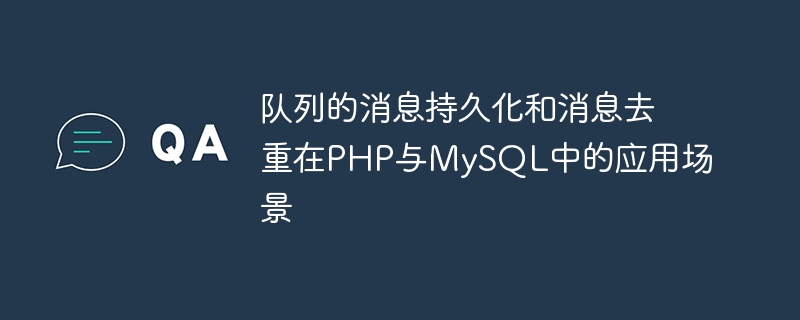

Application scenarios of queue message persistence and message deduplication in PHP and MySQL
Queue is a common data structure that is widely used in software development Applied to asynchronous message processing, task scheduling, log collection and other scenarios. Among them, message persistence and message deduplication are two important features of the queue, which can ensure message reliability and data consistency. In PHP and MySQL, queue applications can use Redis as the message middleware and MySQL to store and manage queue metadata. Specific examples are as follows.
First, you need to install and configure Redis and MySQL to support queue operations. We assume that the installation and configuration of Redis and MySQL have been completed, and the Redis and MySQL extensions have been installed in PHP.
The following is a code example that uses PHP and Redis to implement a queue:
connect('127.0.0.1', 6379); // 将消息插入队列 $redis->rpush('queue', 'message1'); $redis->rpush('queue', 'message2'); $redis->rpush('queue', 'message3'); // 从队列中读取消息 $message = $redis->lpop('queue'); while ($message) { echo $message . PHP_EOL; $message = $redis->lpop('queue'); } ?>
In the above code, we use the rpush method of Redis to insert the message into the end of the queue, and use the lpop method to remove the message from the queue. Read the message at the head of the queue and read through the loop until the queue is empty.
Next, we need to use MySQL to achieve message persistence and deduplication. First, create a table to store the metadata of the message, including fields such as message ID and processing status.
CREATE TABLE `queue` ( `id` int(11) NOT NULL AUTO_INCREMENT, `message` varchar(255) DEFAULT NULL, `status` tinyint(1) DEFAULT '0', PRIMARY KEY (`id`), UNIQUE KEY `message` (`message`) ) ENGINE=InnoDB DEFAULT CHARSET=utf8;
Then, we can write PHP code to persist the message into MySQL, and perform deduplication judgment before inserting to prevent repeated insertion of the same message.
query("SELECT * FROM queue WHERE message = '$message'"); if ($exists->num_rows == 0) { $mysqli->query("INSERT INTO queue (message) VALUES ('$message')"); } // 从队列中读取消息 $result = $mysqli->query("SELECT * FROM queue WHERE status = 0"); while ($row = $result->fetch_assoc()) { echo $row['message'] . PHP_EOL; // 标记消息为已处理 $id = $row['id']; $mysqli->query("UPDATE queue SET status = 1 WHERE id = $id"); } // 关闭连接 $mysqli->close(); ?>
In the above code, we use the mysqli extension to connect to the MySQL database and determine whether the message already exists in the queue through query. If it does not exist, the message is inserted into the queue. When reading messages, we query for unprocessed messages and read each message through a loop and mark its status as processed.
In summary, queue message persistence and message deduplication are commonly used technologies in development, which can ensure message reliability and data consistency. This article introduces code examples for using PHP and Redis to implement queues, and combines them with MySQL to achieve message persistence and deduplication. I hope this article can help you understand the application scenarios and implementation methods of queues.
The above is the detailed content of Application scenarios of queue message persistence and message deduplication in PHP and MySQL. For more information, please follow other related articles on the PHP Chinese website!




